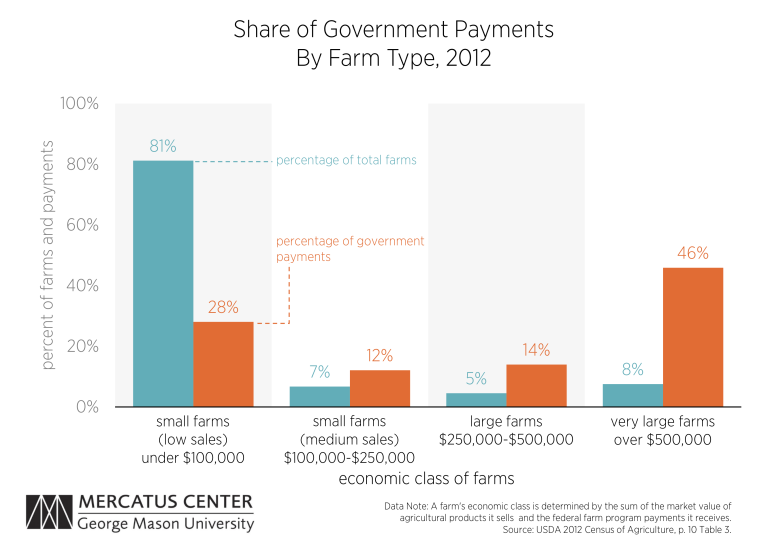- | Corporate Welfare Corporate Welfare
- | Policy Briefs Policy Briefs
- |
Government Failure in the Farm Bill
The purpose of the original Farm Bill in 1933 was to protect small farmers from price fluctuations by limiting supply. However, Vincent Smith, professor of economics at Montana State University, has shown how modern Farm Bill subsidies mostly benefit large farms. Over the 20 years from 1995 through 2014, nearly 90 percent of farm subsidies went to the largest 20 percent of farms—with the top 1 percent of farms receiving 25 percent of all subsidies (see figure 1).

In addition, recent research by Oklahoma State University professor Jayson L. Lusk lays bare the history of the United States Department of Agriculture (USDA) and federal agriculture policy. He describes how the USDA has grown far beyond its original intent and provides further evidence that Farm Bill subsidies are mostly provided to the largest, not the smallest, farms.
Findings by the USDA and the US Government Accountability Office (GAO) support this description:
- The USDA spent $114 billion from fiscal year (FY) 2008 to FY 2012 on 60 different farm subsidy programs.
- In 2012, $8 billion in government payments went to about 800,000 farms.
- Larger farms were more likely to receive a government payment (see figure 2).
- Larger farms received larger payments (see figure 3).
- Larger farms were more likely to receive payments from multiple programs.
As Lusk points out,
"[F]arms that sell less than $50,000 worth of products tend not to receive payments, while the opposite is true for farms with sales greater than $50,000. . . . Payment amounts increase with the size of the farm."
The fact that large farms receive more subsidies than small farms would seem to contradict the Farm Bill’s goal of protecting small, vulnerable farmers from the vagaries of weather, crop disease, or insect pests. Case in point: in the 2012 Census of Agriculture, only 30 percent of small farms received subsidies, while 75 percent of large and very large farms received subsidies (see figure 2). Yet it is the smallest that are the most vulnerable; by one measure (net cash income), farms with sales of less than $25,000 tend to operate at a loss.
The imbalance is clear:
- Small farms account for 88 percent of all farms but receive only 40 percent of government payments.
- Large and very large farms account for 12 percent of all farms but received 60 percent of government payments.
Figure 4 offers an unequivocal conclusion: the biggest farmers benefit the most from the Farm Bill.



Can This Imbalance be Justified?
This disparity could be explained by the fact that the largest farms produce a disproportionate amount of the total US agricultural output—the 160,000 “very large” farms produced almost $320 billion worth of agricultural products in 2012. Stated another way, 7.5 percent of farms produce 80 percent of the national agricultural output. However, these subsidies were justified as a protection for the most vulnerable farms. Larger farms are less vulnerable to unforeseen misfortune because they can more easily diversify their crops, they have better access to credit, and they are generally more efficient owing to economies of scale. Yet “very large” farms still take the lion’s share of subsidies (nearly 50 percent of the total dollar amount).
The more likely explanation for the counterintuitive allocation of subsidies is that larger farms are more organized and better able to take advantage of government programs and, more importantly, better positioned to lobby legislators to expand existing subsidy programs or to create new ones.
While the original Farm Bill explicitly sought to help small farmers, over time it has become pork barrel policy. Matthew D. Mitchell, a senior research fellow at the Mercatus Center at George Mason University, has argued that because of this fierce wrangling for government-granted privilege, the Farm Bill is a good example of government failure. He writes,
"When governments dispense privileges such as insurance subsidies, price supports, or protection from foreign competition, they create incentives for firms to invest large sums of money in obtaining and maintaining these privileges, as the farm bill demonstrates. . . . Members [of Congress] who voted for the bill drew in substantially more political contributions from various agricultural interest groups than those who voted against it, receiving nearly three times as much throughout the period analyzed."
Conclusion
The government failure in the Farm Bill comes from special interest groups wielding undue influence on policy. Jayson Lusk provides insight into this process by telling the story of how the growth of farm subsidies has contributed to the expansion of the USDA. Vincent Smith in turn shows how these subsidies consistently benefit the largest farms. They add evidence to the case for reform of the Farm Bill and the government-granted privilege it represents.


